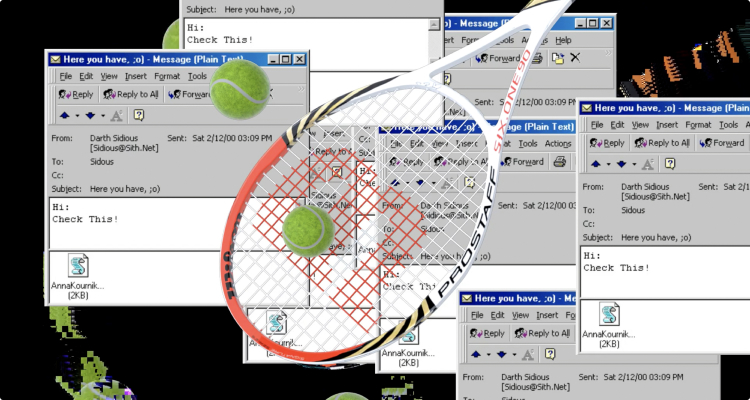Visualizing viruses: How artists depict famous malware
At first glance, cybersecurity and the arts may seem like unlikely bedfellows. However, some artists are fascinated by cyberthreats and the online world. Artists tackle digital security topics by using a diverse array of mediums revealing their wider implications. One exhibition – Malware: Symptoms of Viral Infection – does just that by exploring the digital aesthetics of cyberthreats.

Curated by Bas Van De Poel and Marina Otero Verzier, this exhibition reveals the destructive beauty of computer viruses. Here, various artists create their own visual interpretations of the most famous viruses by using diverse techniques such as collage or simulation software. It creates quite a playful approach to this dangerous topic and also provides interesting insight on the evolution of viruses and the intentions of their creators.
We were lucky enough to have a conversation with Bas, one of the curators, who revealed his own approach to the malware phenomenon and the deeper implications of the project.
NordVPN: How did you become fascinated with the artistic/aesthetic side of malware?
Bas Van De Poel: I believe it started with me learning more about the backstories of computer viruses. For example, the Melissa virus, which was quite a harmful internet worm and caused a lot of economic damage, was named after the developer’s exotic dancer. I started researching more viruses and it turned out that a lot of them have very interesting backstories.
From an aesthetic point of view, I was quite interested in how one would translate something rather abstract, basically just lines of code, into something tangible and visual appealing to which people can react.

N: In the introduction to the Malware exhibition, it says: “Despite their questionable means and damaging effects, the design of computer viruses has in many cases, especially in earlier decades, been connected to radical imaginaries and attempts to create a less unequal and exploitative world.” How do you think viruses have changed since then? Do you think current malware developers still possess a similar goal?
B: Generally speaking, the early DOS viruses often had very strong political messages. For instance, the Marijuana virus was trying to spread the legalization of marijuana.
As technology progressed, viruses became more sophisticated and spread faster via webpages and email. Now criminal organizations started to pay attention and designed malware for financial gain.
From there, as we’ve seen in the past 15 years or so, governmental agencies have been designing malware for geopolitical acts. In some cases, there are definitely more activistic purposes through the development and the design of these viruses. However, generally speaking, it is mostly being used for financial gains or damaging political and corporate systems.

N: What was curating the malware exhibition like? Did you provide participating artists with briefs, or did they have total creative freedom? How did you select artists?
B: I co-curated the exhibition with Marina Otero. There are million types of viruses, so basically we looked at malware, which have had the most significant economical, political or social impact. It’s a linear exhibition – starting with the early DOS viruses all the way to present-day. I collaborated with Tomorrow Bureau from London to bring alive the more recent viruses.
In terms of aesthetics, the era in which these viruses would live was also being reflected in the visual language we used. For example, our Windows viruses were inspired by early 00’s Internet aesthetics, whilst the geopolitical viruses were more advanced collages, composed from found footage and high-end renderings showcasing the political and real-world impact.
N: More recent viruses are represented in more of a collage form. They no longer have the retro aesthetic.
B: Yes, it’s more a contemporary aesthetic, which resonates with our current times.

N: How do you think malware shapes our political/cultural/social landscape? How does it change the ways we use technology and our relation to it?
B: I think, for the first part, it is evident that a lot of these viruses are being utilized for political means. So, for instance, there is the famous Stuxnet virus which targeted five Iranian organizations, suspected to be uranium enrichment infrastructure by causing the fast-spinning centrifuges to tear themselves apart. This was a direct attack on the nation and there are numerous examples, where viruses are being utilized or harnessed for political means.
Coming to your second question, we as humans become more dependent on technology and our lives become more intertwined with it. Meaning that the implications on the physical world have become more significant. There is malware developed to attack pacemakers from a distance. In a different scenario, when we are relying on fully autonomous vehicles, malware could turn a self-driving car into a remotely-controlled weapon.

N: Malware has also became more dangerous due to the increasing popularity of internet-of-things (IoT) environments, where our domestic appliances are all connected to a network. They bring viruses even closer to our daily domestic surroundings.
B: Indeed. The language and terminology associated with early computer viruses was very much informed by biological viruses. For example, terms like “spreading”, “infection” and antivirus software called, for instance, Dr. Norton. These are quite literal references to biological viruses. And now after nearly 40 years, we see that malware starts to have real-life biological implications, for example by attacking a pacemaker or messing with our IoT systems.
N: Cyber threats are not always visible or tangible for most people. Do you think your gallery can or has changed this perception? Is education on the potential dangers of malware one of your goals?
B:The exhibition doesn’t take an educational stand, it just presents the history and evolution of viruses. The practice of designing malware is rather obscure and hidden. The exhibition aims to reveal what’s going on behind the curtains. It informs people about real-world implications, yet it shows just the tip of the iceberg. There are more than a million viruses in the wild and the number is increasing everyday. Advanced technologies like AI and machine learning will enhance an entire new generation of malware, which have even further implications on peoples’ lives.

N: Have you ever encountered malware or any other form of cybercrime outside of the context of your work with art? If so, did it impact your curatorial/artistic activities?
B: My computer was certainly infected, when I was still running a DOS operating system. But it was harmless – just a visual effect projected on my screen. I even enjoyed it. So perhaps subconsciously it infected my design practices and fascination for malware.
N: I remember having a similar one on DOS too that displayed erotic images on my screen. Fortunately, I managed to solve the problem quickly.
B: I guess, for some people, that’s the best virus one can get.
N: Malware has recently been showing up more and more in art as a topic, especially among musicians. Why do you think this topic captivates artists and viewers?
B: I think there is some kind of mystery surrounding it, which inspires people. It is also a little bit dangerous and illegal, which adds up to this interest. It’s in the dark, and I think this is why it has become a fascination and inspiration for contemporary culture.

N: How do you think malware will develop in the distant future?
B: As mentioned, I think malware will only become more and more sophisticated through new technologies like AI and machine learning. As we become more and more dependent on technology it will affect us in a larger way.
Click here to find out more about Malware: Symptoms of Viral Infection.
Want to read more like this?
Get the latest news and tips from NordVPN
